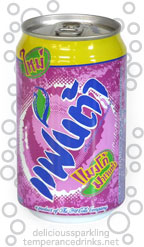Fanta Mango
325 mL can |
History In the decade after Coca-Cola's introduction into Germany in 1929, the country became one of the largest overseas markets for the soft drink. By 1940, however, the company's bottling plants there were no longer able to import syrup used to make the beverage, due to the Allied blockade of Nazi Germany. While some internet conspiracy theories claim that Coca-Cola created Fanta for the Nazis, this is a misleading oversimplification. Simply put: in order to keep the German division in operation despite the lack of materials, local director Max Keith created a new soda which could be made from limited wartime ingredients such as whey and apple pulp. The new recipe was named "Fanta" inspired by the German words for "imagination" and "fantastic". The drink proved a popular beverage and sometimes even used as a sweetener during wartime food rationing. After the war, Coca-Cola re-established its former bottling plants and Fanta was discontinued for a time. After Pepsi entered the European market with a variety of flavors, Coke relaunched Fanta Orange in 1955. Fanta is now available in over 100 different flavors, many of them available only in particular countries or areas. Review Purple. It looks like grape Kool-Aid, a dull purple. The smell is rough and dusty. Are these the most significant qualities of mango flavor? It tastes like a sparkling grape juice: acidic and light. This isn't really much like mango to my mind, but maybe I don't eat mango frequently enough to judge. Its not a bad drink, definitely better than most grape sodas. The dusty bitterness of it stays away from the gooey sweet syrup that most grape sodas fall into, and which makes them so sickening after the first few gulps. But in comparison to juicier or more natural-flavored sodas, this seems flat-textured and dull.
Ingredients Natural water, sugar, flavour artificial and artificial color. Made by Coca-Cola / Thai Numthip Co. Ltd. |
